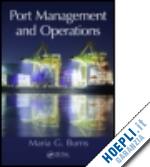Introduction Port Management and Operations: Strategy in the Throes of a Transition Port Authorities, Departments and Activities Ports’ Strategy in the Throes of a Transition The History of Ports: Advanced Thinking, Planning, and Development Ports’ History and Etymology: A Passage, a Journey, and a Haven Advanced Thinking: National Ports, Diplomacy, and Economy Ports’ History, Planning, and Development Port Ownership, Structure, and Organization Forms of Port Ownership, Structure, and Organization Port Governance Port Ownership and Structural TypesPort Privatization Port Workforce: Productivity, Growth, and Empowerment Strategies Measuring Productivity, Throughput, and Growth The Econometrics of Labor and Production Port Growth, Productivity, and Empowerment References Connecting Hub Port Gateways to the Inland Infrastructure Logistics Integration of Port Activities The Five Stages of Integration for the Maritime IndustryStrategic Location and Market Accessibility for Existing and Emerging Seaports Ports’ Success Factors Supply Chain Opportunities, Competition, and Conflict Prevention ReferencesPort Management and Economic Growth Establishing a Port’s Competitive Edge in a Niche World Comparative Advantage, Competitive Advantage, Absolute Advantage and Niche: Better, the Best or Simply Different? Economic Growth as the Space between Stimulus and Response Physical versus Strategic Growth Trade, Protectionism, and Free Trade Risk Assessment (RA) and Risk Management (RM): How Far Can We Go? The Risk Assessment Methodologies Risk and Business Longevity References Port Operations Port Management Services: Terminal Operators; Property Leasing Opportunities Port Management Services and Operations The Harbormaster’s Department and Functions Terminal Manager Vessels’ Planning The Four Stages of Port Management and Operations Marine Terminal Operator (MTO) Agreements and Leasing Opportunities Marine Terminal Operators and Leasing Opportunities: Case Studies Berths, Facilities, and Equipment Berth Performance versus Capacity Port Operations: The Place where Capacity and Performance Meet The Port and Charter Party Terms Charter Party Types Charter Party Clauses and Areas of DisputeThe Port and Charter Party Terms Shipyards Introduction: The Global Shipbuilding Market The Utility of Shipbuilding The Components of Shipbuilding Intellectual Property RightsThe History of Shipbuilding Reasons for Shipyards Losing Market Share Contemporary Shipbuilding Trends Shipbuilding and Oil Market Analysis Global Market Analysis Conclusions Port Agents: Liner Services, Tramp Trade, and Offshore Support Agents FONASBA Agency Selection and Practices Port Agency Responsibilities General Agency Duties, for Tramp, Liner, and Logistics Services Port-Related Claims and Legal Liabilities Conflict Resolution: Arbitration versus Court of Law Port-Related Claims and Charter Party Clause Interpretation Port or Berth Charter Party Nominating a "Safe Port" When a "Safe Port" becomes "Temporarily Unsafe" When Communication becomes a Prerequisite to Port Safety Stevedore Damage and Bills of Lading Stipulations Safe Port, Security, and Loss of Time Ship’s Off-Hire, Time Lost, and Piracy Clauses Multimodal Transportation ReferencesPort and Terminal Investment Public versus Private Investment Return on Investment and the Impact on Trade Growth Port Subsidies and Investment: Challenges and Opportunities Port Subsidies Foreign Investment References Ships’ Size, Ports’ Size: A New Era Ahead International Trade Agreements as Tools to Growth The General Agreement on Tariffs and Trade The World Trade Organization Multiregional Partnerships The Americas Asia Africa Europe Middle East Ports’ Growth and the Global Trade Agreements Matrix Ports and Ships as Derived Demand: Traffic Forecasting Ports and the Principles of Derived Demand Shipping, Ports, and the Ripple Effect Optimum Size and Economies of ScaleCapacity Utilization, Capacity Management, and Capacity Planning: Ports’ Technology and Innovation Capacity Utilization, Capacity Management, and Capacity Planning Port Capacity and Competition Port Technology and InnovationReferences Strategic Alliances, Market Positioning, and Differentiation Developing Holistic Market Positioning and Differentiation Port Strategies and the Components of Holistic Marketing Aligning Workforce with the Port’s Brand Promise Port Marketing Strategy and Competitive Positioning Market Strategy Strategic Alliances, Joint Ventures, Mergers, and Acquisitions: The Economic Patterns of Market Response Ports’ Strategic Alliances Ports’ Joint Ventures Ports’ Mergers and Acquisitions (M&A) Competition and Conflict Prevention Port and Terminal Competition Conflict PreventionEstablishing Long-Term Value through Customer Loyalty Redefining Business Loyalty in the Shipping Industry The Benefits of Practicing Loyal Marketing Measuring Customer Loyalty Target Markets and Competitive Positioning References Key Performance Indicators as Tools of Strategic Planning and Management Strategic Planning, Development, and Management: Exceeding the Corporate Objectives Port Pricing Strategies: Tariff Changing and Competitiveness The Shipping Demand Paradox Port Pricing Pricing Systems and Price-Setting Considerations KPIs: Measuring Financial and Operational Performance Port Equipment and Berth Facilities: Operations, Maintenance, and Depreciation Port Cargo Handling Equipment (CHE) The "Port Equipment List" IT, Logistics, and Operational Port Equipment Depreciation Methods Performance Management and the Human Factor Performance Management The Human Factor in Port Performance Human Factor—Survey Analysis References Leadership and TeambuildingLeadership and Teambuilding Compliance: STCW, the Manila Amendments Leadership and TeamworkMotivation Redefining Leadership and Teamwork through Leadership Styles Employee Motivation, Training, and Development Leadership and Teambuilding Assessment, Drills, and Brainstorming Exercises References Port Authorities and Regulatory Framework ISM: International Safety Management ISPS: International Ship and Port Facility Security Code OHSAS and OSHA: Occupational Safety and Health AdministrationVGP: Vessel General Permit by the US Environmental Protection Agency ISO 14001: Environmental Management System HAZMAT: Hazardous Materials; HAZWOPER: Hazardous Waste Operations and Emergency Response BWM: Ballast Water Management Incident Investigation and Root Cause AnalysisInspections, Surveys, and AuditsGlobal and National Regulatory Compliance for ShipsReferences Ports as a Bridge to Maritime and Offshore Energy Activities Port Operations and Offshore Drilling: When Performance Exceeds AmbitionRegulatory Harmonization among Ports, the Offshore Industry, and OSVs OSVs: The Link between Ports and Offshore Exploration Activities Offshore Regulations in the United States ReferencesThe Future of Ports Port Development Strategy: Elements of Long-Term Strategic Planning Strategic Port Planning Tactical Port Planning Port Planning and the Factors of Production Forecasting the Market Port Management and Forecasting Areas The Risk Element in Forecasting Forecasting Methods and Tools Leading the Way ReferencesIndex











